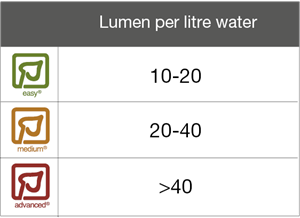 |
Choose the correct light source for your needs
The lumen, level of brightness, is always written on the packaging. Here, we show you how you can put the information from the packaging on the fluorescent tube or bulb to practical use in the aquarium.
Previously, a light bulb or fluorescent tube lamp was classified by how much electricity it used (Wattage). However, this makes it very difficult to compare different kinds of light sources, because light bulbs, fluorescent tube lamps and LED lighting are not directly comparable on this point. It is advisable instead to find the number on the packaging which tells you how many lumens the light source produces. Lumens refer precisely to how much light a particular light source gives off, rather than how much energy it produces. The value is written on the packaging for all light bulbs, fluorescent tube lamps, LEDs, etc.
To make it simple, we explain here how many lumens we recommend per litre of water in an aquarium for a selection of plants from the Easy, Medium or Advanced category.
(20 lumens corresponding to 0.5 watt T5 tube per litre, 40 lumens corresponding approximately to 1 watt T5/litre.)
|
|
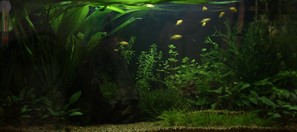
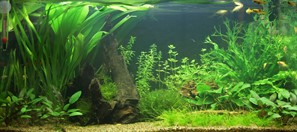
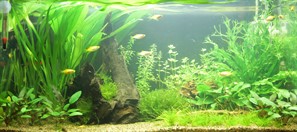
|
How much light is enough light?
That all depends upon which plants you have chosen for your aquarium. If you have chosen nothing but "Easy" plants, 10-20 lumen (0.25 to 0.5 watts) per litre is adequate. For "Medium" plants, we recommend 20-40 lumen (0.5 to 1 watts) per litre, while "Advanced" plants require more than 40 lumens (1 watt) per litre.
The picture series shows the same aquarium (54 litre starter set) with A) standard T8 tube of 15 Watts, B) T5 tube of 24 Watts, and C) 2 x T5 tubes with 24 Watts per tube, in order to visualize how much more light is given off by using a T5 tube rather than a T8 tube, the same amount as you get from switching from one tube to two tubes.
A simple and cheap way to use the light optimally is by always using a good reflector (read more about reflectors here) as well as by ensuring that the temperature - especially during summer - does not get too high inside the lamp (read more about the amount of light given off and temperature here).
Our recommendations, in lumens/watts per litre, are given based upon many years' experience using T5 fluorescent tube lighting.
|
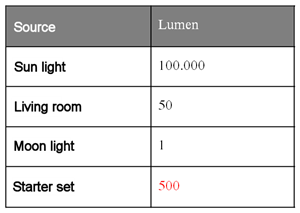 |
The table shows the amount of light (lumens) from one 15 Watt T8 tube in a starter set compared with sunlight, typically that found in the living room - there is more light in the aquarium than in the living room, but considerably less than plants would experience under natural growth conditions.
|
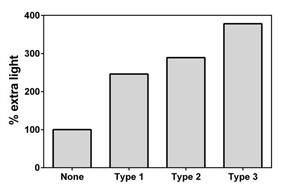 |
Remember to use reflectors in your lamp so as to get up to 4 x better use out of the light!
Many cheap starter sets are delivered with a standard lamp without reflectors. Luckily, it is possible to buy reflectors separately and mount them afterwards in the vast majority of lamps.
Our calculations show that a good reflector can give up to 4 times better utilization of the light. Note that there is a large difference in the quality of reflectors - we have tried to illustrate this with a photo series!
It is easy to ascertain in the shop which reflector is best. Mount the reflector on a fluorescent tube lamp and look at the reflection of the tube in the reflector. If there is no black band visible in the reflection, the reflector is "perfect". If black stripes appear in the reflection (see the example on the right in the top picture), it means there are areas of the tube from where the reflector cannot catch the light - which reduces the utilization of light. As a rule of thumb however, even a poor reflector (e.g. Type 1) is far better than no reflector at all (None)!
|
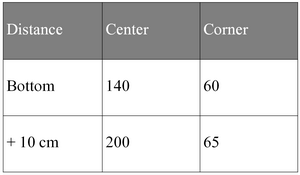 |
The amount of light decreases considerably with the distance from the light source to the base of the tank, and from the centre out to the corners of the aquarium. In daylight, this distance doesn't mean anything, as the distance to the sun is enormous. But from the artificial light source, the distance is much less and therefore critical for how much light the plants receive.
We have constructed a simple light calculation using a plate to represent the base of an aquarium, with the light source 30 cm over the plate. We have measured from the centre of the aquarium out into the corners, and the same at 10 cm in height (likewise, from centre out into the corners). As is evident from the table, there is considerably more light just under the light source in the centre of the aquarium while the light decreases drastically in the corners. By lifting the plant a mere 10 cm up towards the lamp, it will get 40% more light. This effect is not found in the corners, due to the poor spread of the light from the source (the fluorescent tube). The plants can easily be lifted up towards the light by placing them on a rod or a stone.
The most light-demanding plants can always be placed advantageously in the centre of the aquarium, preferably lifted up towards the light - while plants from the Easy category such as Microsorum and Cryptocorynes grow just fine along the edges.
|
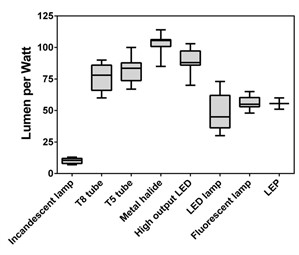 |
There are many different types of light source available, from the old-fashioned light bulb and metal halide lamps to the modern types of LED lights.
The figure below shows how much light is given by the different types of lighting (|---| give off the entire interval, the box gives out 50% of the observations and the small horizontal line is the median value). The figure clearly shows that the light bulb (incandescent) is the light source, which gives off least light per Watt it uses (lumens per Watt).
It also shows that the old-fashioned T8 tube gives out almost as much light per Watt as the more modernT5 tube. Why do so many plant aquarists then switch to T5 tubes, when the T5 came out about 20 years ago? It is because a T5 tube gives out far more light per cm of tube than the T8 tube. One 15 Watt T8 tube is suitable for a 54 litre starter set and gives out just 900 lumens, while a T5 tube of corresponding length uses 24 Watts, but gives out 1600 lumens.
Finally, the figure shows that metal halide lamps are the light source that give out most light per Watt, but they are closely followed by the modern, high output LED lights. The biggest advantage with the two light sources is however that they take up very little space, so it is possible to use a lot of units in an individual lamp, and in this way create an armature that can provide a large amount of light. If you consider however how many lumens you get per Watt, the difference is not actually great enough on its own to justify changing your armature to an LED, for example - but if you are already planning to buy a new lamp, it is perhaps worth considering an LED solution. Read more about LED lighting here!
The different types of energy-saving light bulbs (LED and fluorescent) actually give out considerably less light per Watt, but they can still have their advantages, for those wanting to play around with light in the aquarium. These lamps are bought as spotlights and can provide some nice effects if you add more lights locally to a light-demanding plant group.
|
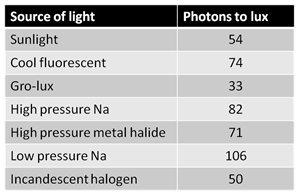 |
Lumen, lux and photon flux are the most usual units for measuring the amount of light - here, we explain what the different units quantify.
Lumen specifies how much a light source gives off - while luxspecifies the amount of light per area (the same as lumen per cubic metre). Lux is therefore used to describe how great an amount of light is available for a plant in a given location in the aquarium. Standard light measurements specify the amount of light in lux.
Photon flux is the scientific term for the amount of light per area, and it specifies the number of photons per cubic metre per second (µmol per m2 per s). The photon flux is often given in wavelength areas of 400 to 700 nm only, which is precisely those wavelengths plants are able to use (see more under What light do plants use?). Photon flux can be converted to lux by multiplying the photon flux by 74 for a coolwhite fluorescent tube light. The factor varies, however, from 33 to 106 according to what kind of light source you have.
It is ideal to talk about the plant's light needs in lux or photon flux, as this is most relevant for plants in terms of how much light reaches their leaves (lux) - and not so much in terms of how strong the light source is (lumens). Exactly how much light plants have available is however primarily controlled by the distance from the light source; the greater the distance, the less light reaches them (See more under Distance from light source).
|